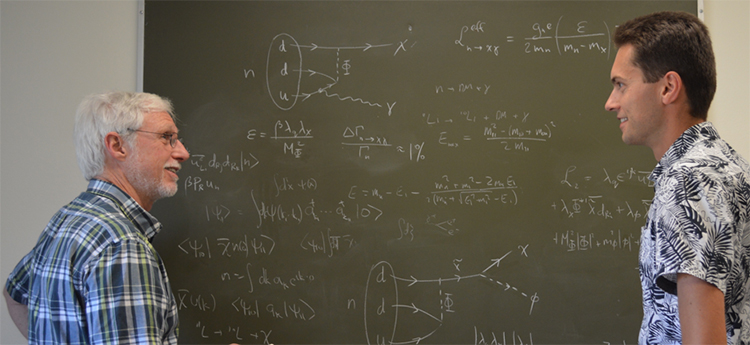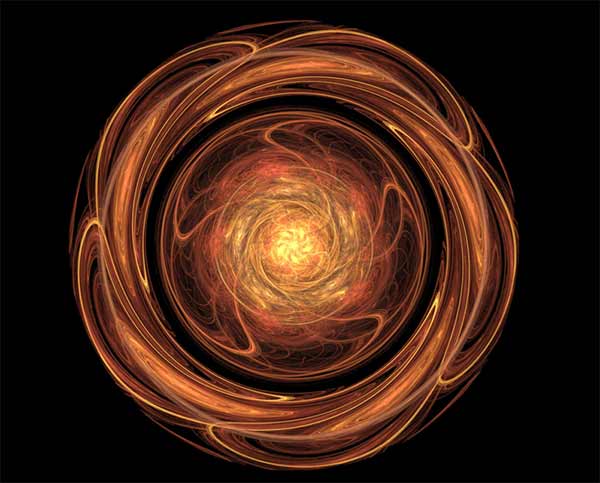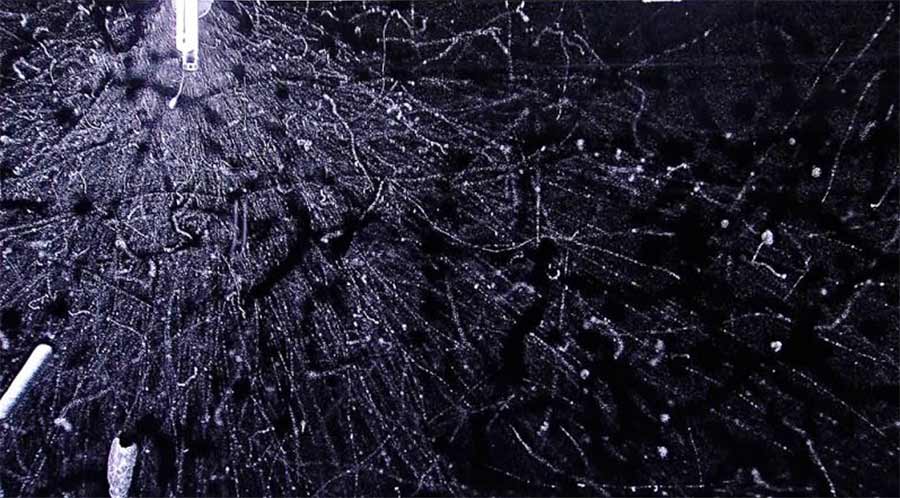
By:
- Cynthia Dillon
Published Date
By:
- Cynthia Dillon
Share This:

Grinstein (left) and Fornal at work. Photo courtesy of the UC San Diego Department of Physics
UC San Diego Scientists: Is a Dark Particle the 'Dark Horse' of Dark Matter?
Dark Matter is more than the name of a show on the SyFy channel. It’s the stuff that makes up about 85 percent of the universe's mass. But because dark matter does not emit light or energy, scientists cannot directly observe it—and it remains one of the biggest mysteries of science.
Enter UC San Diego particle physicists Benjamin Grinstein and Bartosz Fornal. They are proposing a solution that involves the possibility of a yet-to-be-discovered “dark particle” that could account for both dark matter and a defined discrepancy in the field of physics when it comes to measuring neutron lifetime, or time it takes for a collection of neutrons to decrease in number.
In short, Grinstein and Fornal are asking if neutrons are decaying into these invisible ‘dark particles.’

Artistic image of atomic nucleus. Courtesy www.newgrounds.com
“It would be truly amazing if the good old neutron turned out to be the particle enabling us to probe the dark matter sector of the universe!” Fornal said.
Neutrons are subatomic particles similar to protons but without an electric charge. They “live” within the nucleus of an atom. Together, neutrons and protons make up “normal matter”—everything visible in the universe from planets to pencils. Inside the nucleus, protons remain stable and so do neutrons. But “free” neutrons decompose into protons, electrons and anti-neutrinos (anti-matter particles) over time. This decay follows a “half-life” of about 10 minutes—the amount of time it takes for a collection of neutrons to decrease by half. This “lifetime” can be measured scientifically, but with notoriously inconsistent results.
This is where Grinstein and Fornal’s work factors in. They suggest that a neutron can exhibit “dark decay,” meaning that about 1 percent of the time it changes into an elusive “dark particle.” This new dark particle, in its final state, may interact so weakly with normal matter that it escapes detection—which could explain why dark matter has never been observed.
Implications of Dark Particle Hypothesis
For more than 80 years, scientists have studied neutrons and learned how to measure their lifetime in two ways: the beam and bottle methods. Scientists have also come to know the unsatisfying results. To address these discrepancies, Grinstein and Fornal applied mathematics in their quest to explain the universe. Their methodology also involved theoretical research, discussion, tried-and-true pen and paper, and chalk and a chalkboard to sketch out their theory.
“Once the lightbulb went off, we had one idea after another and things progressed very fast,” described Grinstein. “We enjoyed the pace and the feeling that we may be on to something important—and that we may be the first ones in the world to realize this!”
Their realization—scientifically, their hypothesis—is that the dark particle emerging from dark decay may account for most of dark matter.

Graphic representation of dark matter. Image by Nuledo/Wikimedia Commons, courtesy of gizmodo.com
“While this hypothesis must be tested, an inference can be made,” noted Grinstein. “If this is correct, it would have enormous implications.”
First, it would require the existence of a new fundamental elementary particle that is not part of the current accepted paradigm. This, in turn, could change dramatically the way we understand the constitution of matter at its core.
“Secondly,” he continued, “the new particle could help understand the dark matter mystery, arguably one of the central puzzles of modern physics.”
Additionally, according to Grinstein, the disintegration of nuclei by the suggested mechanism of dark decay could open up a whole new field of study on nuclear structure.
Many people likely wonder what makes up the majority of our universe, and others wonder about the subatomic world—what we’re made of, he said. “And our proposal addresses both of these issues at their core.”
This research was supported in part by the DOE Grant No. DE-SC0009919.
The first students to enroll at UC San Diego in 1960 were graduate students in the Department of Physics. Part of the Division of Physical Sciences, the department’s graduate program is ranked #16 by U.S. News and World Report.
Share This:
You May Also Like
Stay in the Know
Keep up with all the latest from UC San Diego. Subscribe to the newsletter today.


